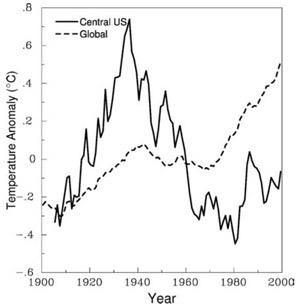Reference
Kunkel, K.E., Liang, X.-Z., Zhu, J. and Lin, Y. 2006. Can CGCMs simulate the twentieth-century "warming hole" in the central United States? Journal of Climate 19: 4137-4153.
Background
Citing the work of Folland et al. (2001), Robinson et al. (2002) and Pan et al. (2004), the authors note there was a lack of warming throughout the central and southeastern United States over the course of the 20th century, which phenomenon was dubbed a "warming hole" by the latter set of investigators.
What was done
For an area they denote the Central United States (CUS), which they describe as "one of the most agriculturally productive regions of the world and roughly defined around what is known as the 'Corn Belt'," Kunkel et al. used a data set of 252 surface climate stations with less than 10% missing temperature data over the period 1901-1999 to construct the CUS temperature time series plotted in the figure below, where mean global temperature as determined by Hansen et al. (2001) is also plotted. Then, for comparative purposes, they examined 55 coupled general circulation model (CGCM) simulations driven by "modern estimates of time-varying forcing," plus 19 pre-industrial unforced simulations, all derived from 18 CGCMs.
Figure 1. Twentieth-century Central United States and mean global temperature anomalies, as described in the text above. Adapted from Kunkel et al. (2006).
What was learned
It is obvious, as shown in the figure above, that the Central US 20th-century temperature series is vastly different from that of the globe as a whole, at least as it is represented by Hansen et al. In fact, rather than the final temperature of the 20th century being unprecedented over the past two millennia, as climate alarmists typically claim, the final 20th-century temperature of the Central US was more than 0.7°C cooler than it was a mere 65 years earlier. In addition, Kunkel et al. report that "the warming hole is not [our italics] a robust response of contemporary CGCMs to the estimated external forcings."
What it means
In the words of the researchers who conducted the study, "the warming hole indicates that anthropogenic forcing of the climate system can be accompanied by a regional temperature response different than expected," which fact "has important implications for impacts assessments." Indeed, it suggests that such model-based assessments can be radically wrong. It is also of interest to note that "during the period of most significant greenhouse gas buildup over the past century, i.e., 1930 and onward" - as we repeat issue after issue in our Temperature Record of the Week feature - the bulk of the United States, whose 20th-century CO2 emissions exceeded those of all other nations, experienced no net warming.
References
Folland, C.K. and Coauthors. 2001. Observed climate variability and change. In: Houghton, J.T. et al. (Eds.), Climate Change 2001: The Scientific Basis, Cambridge University Press, Cambridge, UK, pp. 99-181.
Hansen, J., Ruedy, R., Sato, M., Imhoff, M., Lawrence, W., Easterling, D., Peterson, T. and Karl, T. 2001. A closer look at United States and global surface temperature change. Journal of Geophysical Research 106: 23,947-23,963.
Pan, Z., Arritt, R.W., Takle, E.S., Gutowski Jr., W.J., Anderson, C.J. and Segal, M. 2004. Altered hydrologic feedback in a warming climate introduces a "warming hole." Geophysical Research Letters 31: 10.1029/2004GL 020528.
Robinson, W.A., Reudy, R. and Hansen, J.E. 2002. On the recent cooling in the east-central United States. Journal of Geophysical Research 107: 10.1029/2001JD001577.
Reviewed 31 January 2007




